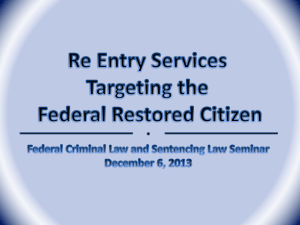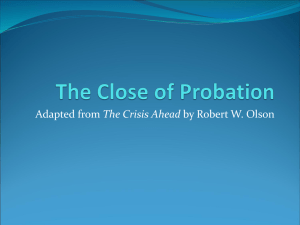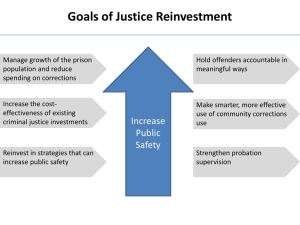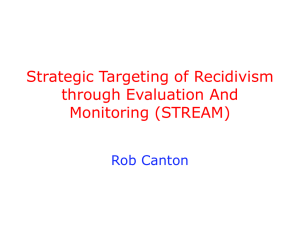Chapters 7-9 PowerPoint
advertisement
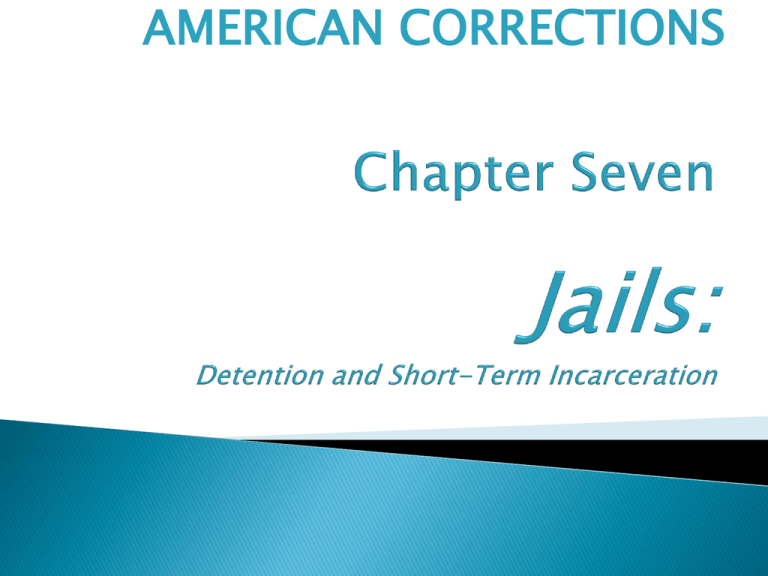
AMERICAN CORRECTIONS 1. 2. 3. 4. 5. Describe the history of the jail and its current function in the criminal justice system. Describe who is in jails, and why they are there. Discuss the kinds of jails in the United States. List the main issues facing jails today. Outline the problem of bail and list the main alternatives to bail. 6. 7. 8. Outline the problems of jail administration. Describe new developments in jails and jail programs. Critically assess the future of the jail. Learning objective 1: Describe the history of the jail and its current function in the criminal justice system. • Jails in U.S. descend directly from feudal practices in twelfth-century England. – Officer of crown, reeve appointed in each shire. – To collect taxes, keep the peace, and operate the gaol (jail). • English settlers brought these traditions and institutions with them to American colonies. – Jails used to detain accused persons awaiting trial and to shelter misfits. Jails often in Sheriff’s homes. Reform movement of the 19th century ◦ Overwhelming majority of accused and convicted misdemeanants were held in jail. Learning objective 2: Describe who is in jails, and why they are there. • Bureau of Census – Nationwide census of jails – Repeated every 5 years – Annual survey supplements nationwide account: • Top 1/3 largest jails • Hold 75% of inmate population • National Jail Census – 86% of inmates are men – 2/3 under 35 YOA – Over 2/5ths are white – Most little education and low income Increasing rate of incarceration for African Americans. Learning objective 3: Discuss the kinds of jails in the United States. • Of 2,876 jails in U.S.: – 80% have county-level jurisdiction – Most administered by elected sheriff • • • About 600 municipal run jails 6 states run jails Estimated 13, 500 police lockups: – A facility authorized to hold people before court appearance for up to 48 hours. Most run by local police agencies. 50 largest jurisdictions hold almost 1/3 of nation’s jailed inmates. ◦ Largest – Los Angeles, New York Hold about 33,300 inmates together (4% of nations total). L.A. County Men’s Central Jail holds almost 20,000 people. Most jails much smaller, holding fewer than 50 people. Learning objective 4: List the main issues facing jails today. Suicide: ◦ Hours immediately following arrest are often a time of crisis: Vulnerability Hopelessness Fear of loss of freedom Sheer terror ◦ Over 1/3 of deaths occurring in jails are suicides ◦ Most happen within first 6-10 hours Jails lack programmatic flexibility to accommodate range of needs of population. Reducing anxiety: ◦ Conversation with staff ◦ Involvement in some activity ◦ Communication Mental Health Problems: ◦ Almost 2/3 of jail prisoners have a history of mental problems. ◦ 1/5 have a very recent history of mental disorder. ◦ Most jails lack resources to provide care. Substance Dependency: ◦ Half of all people placed in jail were under the influence of alcohol or illegal drug at time of arrest. ◦ Over 2/3 have a history of substance abuse ◦ More than 1/2 have history of failed drug treatment ◦ Most dramatic problem is withdraw Medical needs: ◦ Minor scrapes and bruises to major injuries. ◦ Routine health deficiencies of lower class: Infections Poor nutrition Lack of dental care ◦ More than 1/3 of those in jail report physical aliment. ◦ 60% of jails make prisoners pay for medical care Legal needs: ◦ People locked up suffer a disadvantage preparing for case. ◦ Likely to need public defender. Learning objective 5: Outline the problem of bail and list the main alternatives to bail. Bail: ◦ An amount of money, specified by a judge, to be posted as a condition for pretrial release to ensure the appearance of the accused in court. Bondsman: ◦ An independent businessperson who provides bail money for a fee, usually 5-10 percent of the total. Dissatisfaction with bail stems from several factors: ◦ Many, in some cases over 90% of pretrial detainees cannot afford bail. ◦ Money is a weak incentive for appearance in court in many cases ◦ Human freedom can be had for a price Release on recognizance: ◦ Pretrial release because the judge believes the defendant’s ties in the community are sufficient to guarantee the defendant’s appearance in court. Day reporting center: ◦ Facility where offenders such as pretrial releases and probation violators attend daylong intervention and treatment sessions. • Pretrial Diversion: – An alternative to adjudication in which the defendant agrees to conditions set by the prosecutor in exchange for withdrawal of charges. • Diversion controversy: – Many offender’s crimes are caused by special problems – vagrancy, alcoholism, emotional distress. – Formal criminal labeling often works against rehabilitation. – Diversion is cheaper than criminal justice processing. Learning objective 6: Outline the problems of jail administration. Legal liability Jail standards Personnel matters Jail crowding Jail facility 42 U.S.C. 1983 Lack of funds not an excuse Injurious conduct Jail budgets have been increased to pay for: ◦ Training programs ◦ Classification procedures ◦ Managerial policies Important for 3 reasons: ◦ Indicate proactive criteria ◦ Provide a basis by which administrators can evaluate staff performance ◦ Standards facilitate the planning and evaluation of jail programs by giving program managers a target to consider in their work. Local corrections workers are among: ◦ Most poorly trained ◦ Least educated ◦ Worst paid employees in CJ system Understaffing Turnover high Jails handle wide variety of individuals including: ◦ Drug addicts ◦ Mentally ill ◦ Alcoholics State correctional facilities does not immediately accept sentenced prisoners. Almost 90% of all jail cells are at least 50 years old Jails expensive structures, cost: ◦ $100,000 - $200,000 per cell Idle prisoners Learning objective 7: Describe new developments in jails and jail programs. • New generation: – Facility with a podular architectural design and management policies that emphasizes interaction of inmates and staff and provision of services. • Podular unit: • Direct supervision: – Self-contained living areas for 12-25 inmates, composed of individual cells for privacy and open areas for social interaction. – Method of correctional supervision in which staff members have direct physical interaction with inmates throughout the day. Therapeutic justice: ◦ A philosophy of reorienting the jail experience from being mostly punitive to being mostly rehabilitative. Learning objective 8: Critically assess the future of the jail. General trends: ◦ Many jurisdictions have renovated or replaced jail facilities since the early 1970s. ◦ Many jurisdictions are joining together to build and maintain a single jail to serve their collective needs. Probation 1. 2. 3. 4. 5. Describe the history and development of probation, including how it is organized today. Describe the two functions of probation. Discuss the purpose and content of the presentence investigation report. Describe the major issues involved in the presentence investigation. Describe the dynamics that occur among the probation officer, the probationer, and the probation bureaucracy. 6. 7. 8. 9. 10. Discuss the different kinds of probation conditions and tell why they are important. Define recidivism and describe its importance to probation. Define evidence-based practice and discuss its importance. Describe what is known about the effectiveness of probation supervision. Discuss the revocation of probation, including “technical” revocation. Learning objective 1: Describe the history and development of probation, including how it is organized today. John Augustus first to provide bail for defendants under authority of Boston Police Court in 1841 Judicial reprieve: ◦ A practice under English common law whereby a judge could suspend the imposition of execution of a sentence on condition of good behavior on the part of the offender. • Recognizance: – Formally recorded obligation to perform some act entered by a judge to permit an offender to live in the community, often on posting a sum of money as surety, which is forfeited by nonperformance. • Augustus also developed: – Presentence investigation – Supervision conditions – Social casework – Reports to the court – Revocation of probation Today offenders placed on probation in 1 of 4 ways: ◦ Judges impose a sentence of probation (60%) ◦ Judge impose a sentence of probation that is suspended pending good behavior (22%) ◦ For those already on probation, additional sentence is imposed but its activation is suspended (9%) ◦ Split sentence (9%) Centralized or decentralized? Administered by the judiciary or the executive branch? Combined with parole services or not? Decentralized: ◦ Administered by city or county instead of a state ◦ Smaller, more flexible ◦ Better able to respond to unique problems of community Centralized: ◦ Larger, can train staff to take a variety of roles ◦ Can implement broader programs • Judiciary: • Executive branch: – Probation more responsive to the desires of the sentencing judge – Morale of probation officers higher who work closely with judges – Judiciary ill prepared to manage human service operation – Requires full attention of professional public administrators – Better allocation of probation services – Increased interaction between corrections and allied human services – Increased access to the legislature and budgeting process – More appropriate service priorities Subtle differences hard to sustain Difference in criminal lifestyle Learning objective 2: Describe the two functions of probation. • Investigation – Presentence investigation report: • An investigation and summary report of a convicted offender’s background, which helps the judge decide on an appropriate sentence. • Supervision – 3 steps • Probation officer establishes relationship with offender and defines the role of officer and offender. • Officer and offender establish supervision goals to help offender comply with conditions. • Officer decides how to terminate probation. Learning objective 3: Discuss the purpose and content of the presentence investigation report. Purpose: ◦ ◦ ◦ ◦ Help judges select an appropriate sentence Help classification decisions Facilitates treatment planning and parole decisions Document for systematic research • Contents: – Verification: • PSI information is cross-checked with some other source for accuracy. – Objectivity: • Avoiding vague conclusions about the case. • Victim impact statement: – Descriptions in PSIs of the costs of the crime for the victim, including emotional and financial losses. Learning objective 4: Describe the major issues involved in the presentence investigation. Recommendations ◦ Person without authority is suggesting what the sentence should be ◦ Congruence of PSI and sentences range from 70 to 90 percent Disclosure: ◦ Williams v. New York (1949) Judge imposed a death sentence on basis of evidence in PSI despite jury’s disclosure ◦ Cleansing: Confidential comments from a private citizen that might endanger the citizen Clinical statements or evaluations that might be damaging to the offender if disclosed. Private PSIs ◦ Client-specific planning: Private investigative firms contract with convicted offenders to conduct comprehensive background checks and suggest to judges creative sentencing options as alternatives to incarceration. ◦ Court hires private investigator to provide report ◦ Private reports likely more costly than traditional alternatives Learning objective 5: Describe the dynamics that occur among the probation officer, the probationer, and the probation bureaucracy. • The Officer: – Officer role conflict: • Enforcing the law • Helping the offender – Power: • The ability to force a person to do something he or she does not want to do. – Authority: • The ability to influence a person’s actions in a desired direction without resorting to force. • The Offender – Response to supervision strongly influences the overall effectiveness of probation. – Offenders may see the officer as occupying a commanding role. – Officers decide on style, supportive or controlling – Probationers commonly resent their status • The Bureaucracy – Imposes both formal and informal constraints Learning objective 6: Discuss the different kinds of probation conditions and tell why they are important. ◦ Standard conditions Constraints imposed on all probationers ◦ Punitive conditions Constraints imposed on some probationers to increase the restrictiveness of painfulness of probation, including fines, community service, and restitution. ◦ Treatment conditions Constraints imposed on some probationers to force them to deal with a significant problem or need, such as substance abuse. Learning objective 7: Define recidivism and describe its importance to probation. Recidivism: ◦ The return of a former correctional client to criminal behavior, as measured by new arrests or other problems with the law. Important because it reflects the effectiveness of a probation strategy. Learning objective 8: Define evidence-based practice and discuss its importance. • Using correctional methods that have been shown to be effective by well-designed research studies. – Important characteristics: • Focus the program on high-risk probationers (risk principle). • Provide greater levels of supervision to higher-risk clients (supervision principle). • Provide treatment programs designed to meliorate the problems that produce the higher risk level (treatment principle). • Make referrals to treatment programs (referral principle). Learning objective 9: Describe what is known about the effectiveness of probation supervision. • • • Generally no difference among different probation strategies, but compare probation against itself. Probation works more than doing nothing. Probation works better than most people suspect. – New York study: • Prevented new arrests • Probation more effective than jail Learning objective 10: Discuss the revocation of probation, including “technical” revocation. • Probation ends in 1 of 2 ways: – Person successfully completes the period of probation – Person’s probationary status is revoked because of misbehavior • Revocation results from: – New arrest – Conviction – Rules violation Rules violations that result in revocations are referred to as technical violations. ◦ Technical violation: The probationer’s failure to abide by the rules and conditions of probation (specified by the judge), resulting in revocation of probation. Technically not illegal behavior: Changing residence without permission Failure to attend therapy program Neglecting to report to probation office Intermediate Sanctions and Community Corrections 1. 2. 3. 4. 5. Describe the rationale for nonincarceration penalties. Describe the rationale for intermediate sanctions. Illustrate the continuum-of-sanctions concept. Explain some of the problems associated with intermediate sanctions. List the various types of intermediate sanctions and who administers them. 6. 7. 8. 9. Describe what it takes to make intermediate sanctions work. Assess the role of the new correctional professional. Explain how community corrections legislation works and describe its effectiveness. Critically assess the future of probation, intermediate sanctions, and community corrections. Learning objective 1: Describe the rationale for nonincarceration penalties. Enormous cost of imprisonment Other reasons: ◦ Imprisonment is too restrictive for many offenders ◦ Traditional probation does not work with most offenders ◦ Justice is well served by having options in between Most sanctions in Western democracies do not involve imprisonment ◦ For every offender in prison, 3 are on probation or parole. Prison not effective in most cases ◦ Public sentiment Probation may not work with serious offenders. Intermediate sanctions can improve supervision in 2 ways: ◦ Can intensify supervision ◦ Can provide specialized programs better suited to address the offender’s needs Limited sentencing choices Intermediate sanctions allow a closer tailoring of the punishment to the offender’s situation. Learning objective 2: Describe the rationale for intermediate sanctions. Continuum of sanctions: ◦ A range of correctional management strategies based on the degree of intrusiveness and control over the offender, along which an offender is moved according to his or her response to correctional programs. Learning objective 3: Illustrate the continuum-of-sanctions concept. Advantages: ◦ Increases corrections system’s flexibility ◦ Decreases prison and jail overcrowding by moving selected offenders to less-restrictive options ◦ Allows more-responsive management of individual offenders ◦ If person not reporting, a brief home confinement can be followed by a return to probation ◦ Costs less than other alternatives Learning objective 4: Explain some of the problems associated with intermediate sanctions. • Selecting agencies: – Correctional agency administrators argue they should administer sanctions: • Critics say these agencies cannot support midrange activities • Selecting offenders: – Stakes: • The potential losses to victims and to the system if offenders fail; stakes include injury from violent crimes and public pressure resulting from negative publicity. Widening the net: ◦ Potentially the most damaging ◦ Implementing intermediate sanctions has 3 consequences: Wider nets Stronger nets Different nets Learning objective 5: List the various types of intermediate sanctions and who administers them. Pretrial diversion Fines: ◦ Day fine: A criminal penalty based on the amount of income an offender earns in a day’s work. Forfeiture: ◦ Government seizure of property and other assets derived from or used in criminal activity. Community service and restitution: ◦ Community service: Compensation for injury to society, by the performance of service in the community. ◦ Restitution: Compensation for financial, physical, or emotional loss caused by an offender, in the form of either payment of money to the victim or to a public fund for crime victims, as stipulated by the court. • Day reporting (treatment) centers: – Probation center: • Residential facility where persistent probation violators are sent for short periods. – Restitution center: • Facility where probationers who fall behind in restitution are sent to make payments on their debt. • Intensive supervision probation (ISP): – Probation granted under conditions of strict reporting to a probation officer with a limited caseload. Home confinement: ◦ Sentence whereby offenders serve terms of incarceration in their own homes. Electronic monitoring Shock incarceration: ◦ A short period of incarceration followed by a sentence reduction. Boot camp: ◦ A physically rigorous, disciplined, and demanding regimen emphasizing conditioning, education, and job training. Designed for young offenders. Learning objective 6: Describe what it takes to make intermediate sanctions work. Sanctions to be successful must be carefully planned and implemented Potential obstacles: ◦ Sentencing philosophies and practices ◦ Offender selection criteria ◦ Surveillance and control methods Most important issue Principle of Interchangeability: ◦ The idea that different forms of intermediate sanctions can be calibrated to make them equivalent as punishments despite their differences in approach. The target group: ◦ Intermediate sanctions have 2 general goals: Serve as a less-costly alternative to prison Provide a more-effective alternative to probation ◦ Wrong target group ◦ Applied to non-prison cases ◦ Low risk clients Problems of bias Tough aspects of intermediate sanctions may not be totally positive. Widening the net Costs of stricter measure outweigh the benefits? Learning objective 7: Assess the role of the new correctional professional. Three major shifts in the working environment: ◦ Nongovernmental organizations have emerged to administer community corrections programs. ◦ Increased emphasis on accountability has reduced individual discretion. ◦ Relationship between the professional and the client has become less important than the principles of criminal justice that underlie the relationship. Learning objective 8: Explain how community corrections legislation works and describe its effectiveness. Reducing reliance on prison: ◦ Local justice systems have little incentive to keep their own offenders in local corrections. ◦ Funded by state tax revenues ◦ Centralized, state-administered punishments seem to be more expensive than local corrections. Evaluation of community corrections legislation: Three aims: ◦ To reduce the rate and number of people sentenced to state correctional facilities ◦ To reduce tax revenues spent on corrections by transferring both the costs and the funding to lessexpensive local correctional facilities ◦ To reduce prison populations Learning objective 9: Critically assess the future of probation, intermediate sanctions, and community corrections. Three recurrent problems: ◦ Some way must be found to overcome the seemingly immutable tendency of the CJ system to resist placing in less-restrictive options and to keep increasing the level of corrections. ◦ Community support must increase ◦ Purposes of sanctions must be clarified
